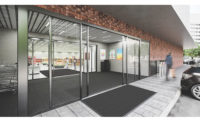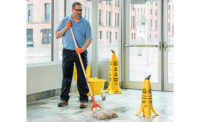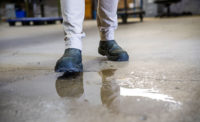Providing clean, safe walkways in public facilities is essential for preventing costly slip, trip and fall (ST&F) accidents. Falls on the same level were the second leading cause of all workplace injuries in 2013 at 16.4 percent of all workplace injuries and resulted in $10.1 billion in direct costs (Liberty Mutual, 2016).1
ST&F events can be caused by several factors, but the floor condition is the easiest to test to assess whether a walking surface is at risk of causing an ST&F event. It’s important to understand the science of ST&F events and the limitations of commonly used devices, called portable tribometers, in assessing floor safety.
The coefficient of friction and floor safety standards
The general field of friction measurement, tribometry, measures the coefficient of friction (CoF) or slip resistance between two objects. For walkway safety, it measures the interaction between the floor and the sole of the shoe.
There are two common methods of interpreting the CoF. The more widely accepted static CoF (SCoF) assumes the shoe is at rest and measures the force needed to start an object moving. The dynamic CoF (DCoF) assumes the shoe is in motion and measures the drag as the shoe contacts the floor to predict the likeliness of a shoe sticking or slipping while walking.
Floor finishes are often used to protect and improve the appearance and safety of a facility’s floor. Only the ASTM D-2047 standard, which is used to measure the SCoF for a dry finished floor has reached a wide level of acceptance. This standard uses the James Machine to measure the SCoF and uses a standard of 0.5 to determine whether the floor finish is slip resistant. However, the standard doesn’t apply to unfinished floors or wet contaminated floors.
Problems with measuring CoF
Slip resistance on contaminated floors has been studied extensively. Gronqvist (1995)2 reported that shoes with smooth/flat soles have good slip resistance on dry floors, but poor slip resistance on wet floors because a smooth-soled shoe is poor at pushing aside the liquid and adhering to the floor compared to one with tread. Shoe tread creates friction and improves the drainage of water from under the shoe sole (Grovqvist, 1995). Studies have also shown that for contaminated floors, the CoF is affected by the shoe material, flooring material, lubricant and the testing method (Jung, 1990).3 Additionally, different areas of a floor can have varying wear, meaning the CoF differs too.
Because the measured CoF will depend upon numerous factors — sole smoothness, size, shoe tread, liquid type and floor surface texture — it’s not possible to use CoF alone to predict whether an ST&F event will occur. A study by Burnfield (2006)4 demonstrated that on a dry floor, as the CoF changes, the probability of a slip changes as well.
- CoF < 0.153, risk of a slip = 81 percent
- CoF < 0.229, risk of a slip = 35 percent
- CoF < 0.320, risk of a slip = 5 percent
The study suggests that using a standard of 0.5 from the ASTM D-2047 test seems to incorporate a reasonable margin for safety in predicting ST&F events, although there may be differences between dry finished and dry unfinished floors.
Studies by Hanson (1999)5 and Choi (2015)6 have also reported that even when certain factors such as shoe and flooring material are known, it’s extremely difficult to accurately predict whether an ST&F event will occur.
Portable tribometers
For many years, portable tribometers have measured the CoF of a floor under various conditions to predict whether it is safe for walking. Their use is controversial for several reasons:
Lack of weight: Portable tribometers that measure DCoF do not generally add weight to the “foot” as would occur while walking, which would affect the slip resistance of the shoe and surface.
Slips precede falls: Falls start with a slip 40-50 percent of the time (Stroebel, 2012.)7 Cham (2002)8 showed that anticipating a slip caused people to change their walking gait, and that their knee and hip may help stop a slip. No portable tribometer appears to model the knee and hip action, so at least half of slips aren’t simulated correctly.
CoF alone is not a good predictor: Ricotti (2009)9 claimed that the CoF also depends on the surface rubbing against it. Portable tribometers offer few materials to use for the simulated foot, meaning they may not be testing materials representative of many shoe soles.
Shoe CoF changes: The CoF of shoe soles changes as they wear. Yet, CoF testing uses new material, making it a poor method of assessing the actual CoF over the life of actual shoes as they wear.
Liquid viscosity varies: Wet surface testing with portable tribometers uses water, yet Li (2004)10 found that oil was more dangerous than water. Thus getting a good test result with water using a tribometer provides little information about whether an ST&F event is likely under other conditions.
Inconsistency between methods
Studies comparing different conditions like shoe material or liquid viscosity have found that the CoF from the portable tribometer is not consistently measured (Jung, 1990). If the CoF is not consistent between testing conditions, it’s difficult to argue that CoF alone can predict the risk of an ST&F event.
Leg motion is not adequately modeled: For DCoF, the leg is assumed to be in motion and the complex motion of a moving leg is only minimally modeled by portable tribometers.
Lack of correlation with James Machine: Portable tribometer results lack correlation with the James Machine results. While different portable tribometers may measure different aspects of the potential for an ST&F event, if that data cannot be correlated against the industry standard, it seems to be of little predictive value.
The significant number of issues associated with accurately modeling the biomechanics of walking, especially during a slip or on a contaminated floor, makes it unlikely that portable tribometers can determine the likelihood of an ST&F event with any reasonable accuracy.
References
- Liberty Mutual Group (2016). Downloaded from: https://www.libertymutualgroup.com/about-liberty-mutual-site/research-institute-site/Documents/2016%20WSI.pdf
- Gronqvist R. Mechanisms of friction and assessment of slip resistance of new and used footwear soles on contaminated floors. Ergonomics, 1995; 38: 224-241.
- Jung K, Schenk H. An international comparison of test methods for determining the slip resistance of shoes. J of Occupational Accidents, 1990; 13: 271-290.
- Burnfield JM, Powers CM. Prediction of slips: an evaluation of utilized coefficient of friction and available slip resistance. Ergonomics, 2006; 49: 982-995.
- Hanson JP, Redfern MS, Mazumdar. Predicting slips and falls considering required and available friction. Ergonomics, 1999; 42: 1619-1633.
- Choi SK, Kudoh R, Koga J, Mikami T, Yokoyama Y, Takahashi H, Ono H. A comparative evaluation of floor slip resistance test methods. Construction and Building Materials, 2015; 94: 737-745.
- Strobel CM, Menezes PL, Lovell MR, Beschorner K. Analysis of the contribution of adhesion and hysteresis to shoe-floor lubricated friction in the boundary lubrication regime. Tribology Letters, 2012; 47: 341-347.
- Cham R, Redfern MS. Changes in gait when anticipating slippery floors. Gait and Posture, 2002; 15: 159-171.
- Ricotti R, Delucchi M, Cerisoa G. A comparison of results from portable and laboratory floor slipperiness testers. Int J of Industrial Ergonomics, 2009; 39: 353-357.
- Li KW, Chang WR, Leamon TB, Chen CJ. Floor slipperiness measurement: friction coefficient, roughness of floors, and subjective perception under spillage conditions. Safety Science, 2004; 42: 547-565.



